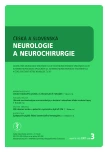IgE Antibody Serum Level Changes in Patients after Severe Head Injuries
Authors:
M. Smrčka; A. Mrlian; K. Ďuriš; J. Karlsson valik; M. Kýr *
Authors‘ workplace:
Neurochirurgická klinika FN Brno
; 1. Dětská interní klinika FN Brno
*
Published in:
Cesk Slov Neurol N 2007; 70/103(3): 259-265
Category:
Original Paper
Overview
Aim:
Transient IgE antibody serum level changes have been described in traumas, burns and after major surgical interventions. This might be caused by stress-induced immune system disturbances. These posttraumatic IgE changes, however, have not been described in neurotraumatology so far.
Material and Methods:
The study involved 35 patients after a severe head injury admitted to the Neurosurgical Department within 2004–5. The peripheral venous blood samples were collected from the patients in three-days´ intervals to study the levels of IgE, IgG, IgM, IgA antibodies and CRP. The dynamics of the IgE levels development was analysed in three samples dependent on the absolute IgE value of the first sample, on gender, GCS, GOS and the type of injury. Then the relation between the development of IgE, other antibodies and CRP was evaluated. The serum IgE values were established by LEIA (luminiscence – enhanced enzyme immunoassay). To normalise the data asymmetry the transformation was performed with the help of logarithm. The data were analysed by ANOVA test for repeated measurements.
Results:
The analysed group showed a significant increase of the IgE levels in time course (p < 0.001). No difference was found in the dynamics of the IgE level changes in relation to IgE value of the first sample, to gender, GOS and the type of injury (p = NS). In GCS 3 patients there was a significantly higher increase of the IgE levels between the second and third samples compared to patients with GCS 4–8 (p = 0,012). The increase of IgE levels if compared to other antibodies was extremely high. The dynamics of the CRP levels corresponded to inflammatory responses, which might be caused by a trauma.
Conclusions:
The report has confirmed a phenomenon of continuous increase in the IgE serum levels seen in patients after severe head injuries. The context of this finding with cellular immunosuppression after a head trauma and with high number of extracranial complications in these patients is not known so far.
Key words:
head injuries – immune system disturbances – immunoglobuline E
Sources
1. Szczeklik A, Jawien J. Humoral immune response to tissue injury, characterized by a rise in serum immunoglobulin E. Pol Arch Med Wewn 1995; 94 : 495-505.
2. DiPiro JT, Hamilton RG, Howdieshell TR, Adkonson NF Jr., Mansberger AR Jr. Total IgE in plasma is elevated after traumatic injury and associated with sepsis syndrom. Ann Surg 1992; 215 : 460-6.
3. Gleich GJ, Dunnette SL, Volenec FJ, Mani MM. Quantification of serum IgE in patients with burns. Clin Allergy 1979; 9 : 133-139.
4. Polacek V, Jira M, Fara M, Strejcek J, Konigová R. Immunoglobulin E (IgE) in patients with severe burns. Burns Incl Therm Inj 1987; 13 : 458-461.
5. Szczeklik A, Jawien J. Immunoglobulin E in acute phase response to surgical stress. Clin Exp Allergy 1996; 26 : 303-307.
6. Kelly JL, O‘Suilleabbhain CB, Soberg CC, Mannick JA, Lederer JA. Severe injury triggers antigen specific T-helper cell dysfuntion. Shock 1999; 12 : 39-45.
7. Smrčka M, Klabusay M, Juráň V, Vidlák M, Máca K. Poruchy imunitního systému u pacientů po kraniocerebrálním poranění. Čes Slov Neurol N 1999; 6 : 316-319.
8. Wiemels JL, Wiencke JK, Patoka J, Moghadassi M, Cheb T, McMillan A, Miike R, Barger
G, Wrensch M. Reduced immunoglobulins E and allergy among adults with glioma compared with controls. Cancor Res 2004; 64(22): 8468-8473.
9. Miller CH, Quattrocchi KB, Frank EH, Issel BW, Wagner FC Jr. Humoral and cellular imunity following severe head injury: review and current investigations. Neurol Res 1991; 13(2):117-124.
10. Wilson NW, Wu YP, Peterson B, Bastion JF. Immunoglobulins and IgG subclasses in children following severe head injury. Intensive Care Med. 1994; 20(7):508-510.
11. Navarro-Zorraquino M, Lozano R, Deus J, Pastor C, Larrad L, Tejero E, et al. Determination of the immunoglobulin E postoperative variation as a measure of surgical injury. World J Surg 2001; 25 : 585-91.
12. Spolarics Z, Siddiqi M, Siegel JH, Garcia ZC, Stein DS, Denny T, Deitch EA. Depressed interleukin-12 - producing activity by monocytes correlates with adverse clinical course and a shift toward Th2-type lymphocyte pattern in severely injured male trauma patients. Crit Care Med. 2003; 31(6): 1722-1729.
13. Schuttrumpf S, Binder L, Hagemann T, Berkovic D, Trumper L, Binder C. Utility of procalcitonin concentration in the evaluation of patients with malignant diseases and elevated C-reactive protein plasma concentrations. Clin Infect Dis 2006; 43 : 468-73.
14. Meisner M, Adina H, Schmidt J. Correlation of procalcitonin and C-reactive protein to inflammation, complications, and outcome during the intensive care unit course of multiple-trauma patients. Crit Care. 2005 Nov 24;10(1). Aviable from URL: http://www.ncbi.nlm.nih.gov/entrez/utils/lofref.fcgi
Labels
Paediatric neurology Neurosurgery NeurologyArticle was published in
Czech and Slovak Neurology and Neurosurgery

2007 Issue 3
Most read in this issue
- Chiari Malformation: Own Experience
- Osmotic Demyelination Syndrome – MRI Diagnosis: a Case Report
- The Brain MR Imaging in Patients with Myotonic Dystrophy DM 1
- Osteoplastic Decompressive Craniotomy
